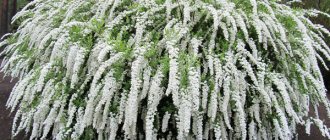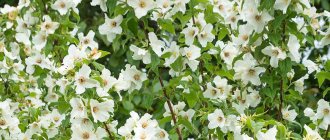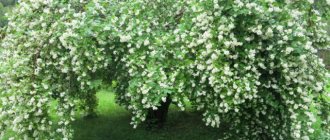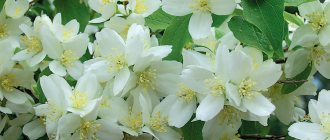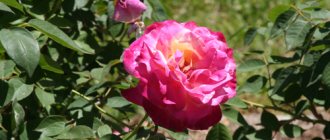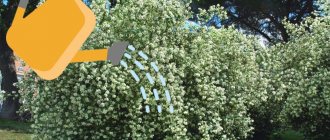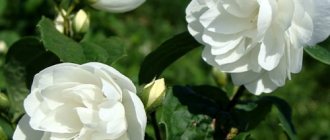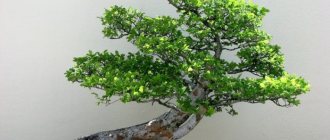Common mock orange (Philadelphus pallidus)
The species is native to Southwestern Europe. The shrub grows up to three meters in height, the foliage is large, up to eight centimeters in length, rich green on the upper side and whitish on the lower side. White flowers bloom in clusters, up to seven buds in one.
The species is frost-resistant and can easily withstand temperatures down to minus 25 degrees. Popular varieties: Virginal, Belle Etoile, Bicolor.
Lemoine mock orange (Philadelphus x lemoinei)
A hybrid species in demand among gardeners in Europe and North America. Up to three meters high, the leaves are small, it blooms in tassels, up to 7 buds in one. Popular varieties: Ermine Mantle, Schneeshturm, Glacier, Charm, Snow Storm.
Despite the fact that mock orange was previously grown in gardens much more often, now it is still very popular. The shrub has high decorative qualities and a pleasant aroma, so with proper care it will delight the gardener with its appearance and smell.
Strawberry jasmine: description
This is the only species with an original two-color flower color that can easily withstand the harsh winters of the middle zone.
- The plant is a low, slender and lush bush with a compact spherical crown.
- From the central trunks of strawberry mock orange, curved burgundy-red shoots fan out, densely covered with elongated bright green ovoid leaves.
- During flowering, jasmine branches are literally strewn with large white inflorescences with a spectacular raspberry-pink eye.
The simple, cup-shaped flowers have four delicate petals with slightly wavy edges.
“Unusual mock orange” received its original name for the unconventional coloring of its lush inflorescences. However, it stands out for another feature - its incredible aroma. In the enchantingly sweet smell, densely exuded by flowering bushes, delicate and sonorous strawberry tones stand out clearly. Therefore, this amazing variety is often called strawberry-scented mock orange.
Planting mock orange
It is best to plant shrubs in open areas where the plant will receive plenty of sunlight. It is best to plant in the ground in the fall, at the end of September or beginning of October.
You can plant the plant in early spring, but in this case it must be done before the buds open, otherwise the likelihood that the plant will take root will be extremely low.
The distance between the bushes depends on whether the gardener plans to form a single planting or wants to create a hedge. In the first case, the distance between the bushes should be at least one meter to facilitate further plant care; in the second - about 50 centimeters.
About a week before the intended planting of mock orange, it is worth preparing planting holes approximately 60 centimeters deep. A drainage layer about 15 centimeters high is added to the bottom of the pit, then a layer of soil consisting of a mixture of earth, sand and humus mixed in a ratio of 3:2:1. After this, the hole is generously filled with water and left for at least seven days to shrink.
When the hole is completely ready, it is necessary to place the seedling in the hole so that the neck of the root is approximately level with the surface of the earth, then the hole is filled with the soil mixture described above. After this, water the plant generously and, after waiting for the soil to shrink, add dry soil on top to level the overall level.
Keep in mind that you should not allow the root neck to be too deep: if it is immersed more than 3-5 centimeters underground, there is a high probability of rotting.
Mock orange varieties for Siberia and the Urals
Mock orange varieties are selected according to the design decision. The varieties differ from each other not only in appearance, height of the bush, but also in the flowering period. The main requirement for mock orange is resistance to frost and adverse environmental factors. All varieties recommended for temperate climates are characterized by high immunity to diseases and pests and are easy to care for. Below are photos and descriptions of several of the most frost-resistant mock orange varieties suitable for growing in Siberia.
Chubushnik Thin-leaved
The earliest variety in Siberia, blooming in early June, flowering duration is 33 days. Resists frosts down to -30 0C. Refers to tall representatives. The wild-growing species is found in Siberia, the Urals and the Far East, the main accumulation is observed on the edges of mixed forests, at the foot of rocky mountains.
External characteristics of mock orange:
- branched, spreading shrub of round shape, the length of perennial stems is 2-2.5 m;
- shoots are slightly pubescent, the bark is smooth and brown until 2 years old; at an older age, the surface becomes rough, the bark peels off in narrow strips, the color becomes dark gray;
- the leaf blade is thin with a smooth surface, the leaves are 8 cm long, rounded with wavy edges, located oppositely;
- inflorescences are large, long, 5-8 flowered;
- flowers are simple, white, 3.5 cm in diameter, oval petals, white stamens, long, numerous with bright yellow anthers.
Chubushnik thin-leaved has a pronounced pleasant aroma.
Mock orange large-flowered
The most common variety of mock orange in Siberia is Large-flowered. The crop is frost-resistant, with an average flowering period of 28 days (from July to August).
Bush up to 3 m high. Densely leafy, spreading, branched, spherical in shape. The flowers are semi-double, white, large, diameter - 4-5 cm. The inflorescences are long, the density of 3-5 flowers.
Attention! Mock orange is distinguished by its complete absence of odor.
Erectus
The photo shows a hybrid form of mock orange Erectus, common in Siberia. Valued for its highly decorative habit. The crop has an average flowering period, lasting 35 days from July to the end of August. In September the leaf color turns red-yellow.
External description:
- height – 1.2-1.5 m;
- the bush is compact, narrow, with a weeping type of stem growth;
- shoots are thin, gray;
- the crown is dense, densely leafy with narrow, dark green lanceolate leaves;
- inflorescences form on the tops of the current year's shoots;
- flowering is abundant, the flowers are large, white, simple, diameter - 4 cm, petals are round and drooping.
The hybrid has no odor.
Mock orange Unusual
The selection variety of the Unusual mock orange was created specifically for the Urals, Siberia and the Moscow region. The culture is characterized by a compact crown, the height of the central shoots does not exceed 1 m. The curved shoots with drooping tops and dark red bark add sophistication to the shrub. The cultivar received its name due to the unusual color of the flowers.
The flowers consist of 4 cream-colored petals at the base with a bright crimson fragment. The brightness of the color depends on the lighting; the stain turns out to be a more saturated color with a sufficient amount of ultraviolet radiation. The leaves are oblong with a sharp apex, pubescent, with coarsely toothed edges. The mock orange variety is early, flowering occurs from June to July. The aroma is subtle with a pleasant strawberry tint.
Elbrus
An elite selection variety of mock orange, widely used for design in botanical gardens of Siberia. Frost resistance is satisfactory for temperate climates; without shelter, young shoots may freeze. Blooms abundantly from July, lasts 25 days.
Description of the hybrid:
- the crown is spreading, the height of the bush is 1.3 m;
- the leaves are narrow, light green, thick with smooth edges, pubescent below, turning yellow in autumn;
- flowers are double, white, large, diameter – 5.5-6 cm;
- the raceme is long – up to 7 cm, the arrangement of flowers is dense;
- variety with a subtle unobtrusive aroma.
Important! Mock orange produces few fruits; the seeds are not suitable for generative propagation.
Circumcision
The shrub grows quickly and erratically, requiring regular pruning. The procedure begins strictly after the start of flowering, because flowers form on shoots no younger than two years old, and excessive removal of such branches will spoil the appearance of the plant.
Branches with weak inflorescences and painful-looking branches are cut off by about a third of their length. When choosing a cut location, pay attention to the location of the upper bud. Choose a place so that the top bud is directed not to the center of the plant, but to its outer part, to prevent their growth into the bush.
Every few years it is worth carrying out thinning sanitary pruning, removing the oldest, thickest branches to rejuvenate the plant.
If you follow the simple principles stated above when pruning, then the shrub in your garden will look as attractive as in the photo of a mock orange from professional greenhouses.
Growing mock orange in Siberia and the Urals
The photo shows the last stage of planting mock orange in Siberia; for further growth, the seedling needs appropriate care, which includes watering, fertilizing and pruning. All varieties recommended for temperate climates are highly frost-resistant, and shoots quickly recover after freezing. To avoid a stressful situation, it is better to cover the plant for the winter.
Watering and fertilizing schedule
Mock orange is a moisture-loving plant with a low drought tolerance. Regardless of the region of growth (both in Siberia and the South), the shrub requires constant watering. The seedlings are watered every 6 days using 5 liters of water. Mature shrub once every 15 days, the required volume of water is 15 liters. This graph is calculated taking into account the complete absence of precipitation. A sign of moisture deficiency will be the loss of turgor in the leaves, they droop and begin to turn yellow at the edges.
They begin to feed mock orange in the second year of the growing season. In the spring, before the formation of buds and during flowering, liquid organic matter is added to the root. After flowering, the tree trunk circle is covered with ash. At the end of August, for better formation of flower buds, they are fed with phosphorus and potassium agents.
Loosening and mulching the soil
The first mandatory loosening is necessary for the mock orange during the swelling of the buds. Subsequent ones are carried out as the weeds grow and the soil dries out. Mulching will eliminate unnecessary loosening, stop the growth of weeds, retain the necessary moisture and protect the roots from overheating in the summer. The mulch layer in Siberia is renewed every spring after the first weeding.
Trimming
In the second year of growth, the shrub will bloom with single flowers, without leaving buds. At the end of summer, the crown of the mock orange is trimmed, the shape and height are adjusted, and in the spring, damaged shoots are cut off, as well as those that are bent and growing inside the bush. In the third year, the plant enters the full flowering phase. After flowering, the shoots are completely removed.
In the 4th year of growth, in addition to the listed activities, rejuvenating pruning is carried out: all stems are cut off at the root, leaving 3-4 young strong shoots. The procedure is carried out every year. If the bush is very thick, thin, old branches are removed from the central part of the bush.
Preparing mock orange for winter in the Urals and Siberia
Adapted mock orange varieties tolerate low temperatures well. Taking into account the fact that the biological species is thermophilic, it is not worth the risk when growing in Siberia. If you do not use shelter from frost, instability in winter temperatures can lead to the death of an annual plant. The bush is mulched, the branches are tied together with twine, and bent to the ground. Cover the top with dry leaves and add a snowdrift in winter. An adult mock orange is watered abundantly, the mulch layer is increased, and the branches are cut to approximately the level of the snow layer. In spring, the shrub will quickly recover and bloom profusely.
Watering and fertilizing
In the first year of life, the plant needs to be watered regularly, but older plants cope well on their own due to their developed root system.
However, during summer droughts, when the weather is hot for a long time, the plant can be helped to avoid its withering. Monitoring the condition of its leaves helps you figure out how to water a shrub.
Due to this self-sufficiency of the plant, it does not particularly need fertilizing, but to stimulate long-term flowering, it is permissible to apply universal fertilizer at the very beginning of spring.
Bloom
The maximum attractiveness of garden jasmine appears when the fragrant flowers open. It is for its pleasant, sweet and powerful aroma that most gardeners love it.
The smell of mock orange has a beneficial effect on the human psyche and improves mood. The plant usually blooms in the 3rd year after planting.
Mock orange flowering time
The flowering period of garden jasmine depends on its type and variety. In the conditions of the Moscow region, the first to bloom is the crown mock orange and garden forms based on it: golden (aureus), dwarf and variegated. They bloom almost immediately after the common lilac (beginning of June).
In the first two weeks of June, small-leaved mock orange, thin-leaved, and Schrenk's mock orange bloom. In early - mid-July, the odorless, grayish, broad-leaved and fluffy mock orange begins to bloom (it blooms later than all others).
The average flowering time is 20-25 days, a little longer in a shady place. Schrenk's mock orange blooms the longest, and, for example, Gordon's mock orange is able to bloom a second time in the fall.
Chubushnik "Zoya Kosmodemyanskaya"
Why doesn't mock orange bloom? What to do?
Garden jasmine may not bloom in some situations. The most common reasons: lack of lighting (grows in the shade), lack of moisture or nutrients (watering, fertilizing), unsuccessful wintering (freezing of annual shoots), excessive pruning in the spring or too deep planting.
Perhaps the mock orange does not bloom due to its age, especially if you grew it from seeds (7-8 years) or from cuttings (4-5 years).
Growing from seeds
Before planting, mock orange seeds require stratification at a temperature of +2-3ºC for two months. It is recommended to prepare a mixture of peat and sand for this, sow the seeds in a container with the mixture and place it in the refrigerator.
After two months, the seeds are planted in a mixture of peat, humus and soil in a 2:1:1 ratio, and the container is covered to create greenhouse conditions. The soil must be moistened 2-3 times a day; seedlings will appear in about a week. Seedlings are planted in open ground after they have grown stronger and formed several leaves.
It is worth considering that propagation by seeds does not guarantee the preservation of the decorative qualities of plants; seedlings can grow into a wild variety of the plant.
Jasmine in folk medicine (recipes)
Against cough
The flowers can be used to prepare cough syrup: pour the flowers into the syrup, cook for about an hour over low heat, cool, strain, and store in the refrigerator.
For pain during menstruation
Warm baths with the addition of a decoction of jasmine flowers reduce the pain of menstrual syndrome.
Against bronchitis and asthma
Asthma and bronchitis are treated with a decoction of the leaves: pour a tablespoon of the raw material into a glass of water, bring to a boil over low heat and cook for 5 minutes. Infuse for one hour, filter, take 40–50 grams up to three times a day before meals.
For calluses
Crushed jasmine leaves in the form of a compress are applied to the callus that appears, and in three to four days they get rid of it.
From temperature
A decoction of the leaves is a good antipyretic.
Propagation by cuttings
For cuttings, annual shoots are selected that can easily take root with a minimum of care. Cuttings must be treated with a root formation stimulator and then placed in a container with nutrient soil at a shallow depth.
The container with cuttings must be placed in greenhouse conditions, and the soil must be regularly sprayed to maintain constant moisture. After the formation of a strong root system, the seedlings can be planted in open ground.
How does jasmine reproduce?
It turns out that garden jasmine shrubs lend themselves to a variety of propagation methods: layering, seeds, green or lignified cuttings.
Dividing the bush
Sometimes, when an adult plant is urgently needed, they resort to dividing the bush. The best time to carry out such an operation is the month of October; the bush is completely dug up, divided into two or three parts with garden shears, making sure that the root shoots are preserved on each of them, and transplanted to a new place.
Green cuttings
The most suitable month for propagation by young cuttings is June, when the cuttings are quite flexible. They are cut early in the morning, when they are most saturated with moisture, the cut under the lower bud is made obliquely, above the upper bud - a straight cut, the leaves are shortened by half.
To stimulate the formation of the root system, the roots are soaked for a day in an appropriate solution (for example, “Kornevin”) and planted in prepared soil to a depth of 3 centimeters with a distance of 5 – 7 centimeters. The planting mixture is prepared by taking:
- sand - one part;
- weathered peat - one part.
After planting the petioles in the garden bed, it is advisable to cover them with a jar to create a greenhouse effect; for the first two days there is no need to lift the jar. Then you will need daily ventilation, spraying the cuttings and shading them from the sun. After a while, roots will begin to appear; during this period, planting needs to be accustomed to the open air.
Know! Young jasmine bushes, planted in a permanent place, begin to bloom only in the third year.
By layering
When there is a desire to renew or the need to propagate a bush by layering, first, with the arrival of spring, all the shoots are cut off from the old bush so that it produces new growth over the summer. The strongest shoots are selected from it and used for propagation:
At the bottom of the shoot you like, a well-developed first bud is found, under which the shoot is tied with wire (aluminum or copper) to stimulate the development of roots in that place. The shoots bend into shallow grooves dug nearby and are additionally secured with wire to ensure better contact with the ground.
The grooves are filled first with wet sand, then with peat, and carefully watered. Over time, after 1.5 - 2 months, new shoots should appear; they need to be spudded a couple of times. In autumn, grown shoots are pruned, separated from the mother bush with a sharp shovel, and planted in a new place.
To help a young seedling survive the winter, it needs additional care: a cap-shaped shelter is built from light material, placed on the tree, and secured.
Lignified cuttings
When propagating jasmine by lignified cuttings, they wait until the bush sheds its leaves in the fall and prepare 15-centimeter-long stems: a straight cut is made under the lower bud, and an oblique cut is made above the upper bud. The branches are placed in boxes with sand, sprinkled with sand on top, and sent to a cool room for storage.
Know! In the spring, the branches must be planted in the ground before the buds begin to swell.
During the spring-summer period, young shoots will grow from the branches.
Seeds
The longest expected result is obtained using the seed method of propagating shrubs. This can take 6–7 years, so this option for growing jasmine is the least popular, although it has its advantages: the seedlings grow strong, hardy, and have good disease resistance.
For recommendations from a specialist in propagating garden jasmine, watch the video.
Creating layering and dividing the bush
These propagation methods are less reliable than cuttings; the level of rooting of young plants formed using these methods hardly exceeds 50%.
However, if a gardener decides to propagate a plant using these methods, he should carry out the process in the same steps as with any other shrubs: mock orange does not require special conditions.
Pests and diseases
Mock orange is rarely affected by any diseases: the plant has strong immunity, most often the reason for the poor health of the bush is a lack or excess of moisture, or its presence in the shade in an unsuccessfully chosen place.
If a plant is affected by spotting or mold, standard treatment with fungicides helps; if harmful insects appear, treatment with insecticides according to the type of infection helps.
Mock orange can be used as an element of garden decoration, as a source of shade and a pleasant smell in the area, or even as a hedge around the perimeter of the area. The decorative properties of the mock orange plant allow you to imaginatively decorate your garden with shrubs without much effort.
Why and what to do if mock orange does not bloom
If garden jasmine does not bloom, diseases or pests are not always to blame. Much more often, the gardener himself is “responsible” for choosing the wrong place for planting or making serious mistakes in care.
Low quality seedlings
To ensure compliance with varietal characteristics and flowering within the specified time frame, plants must be purchased only from stores and nurseries that can guarantee the quality of planting material. Two-year-old seedlings take root best and fastest in a flowerbed.
For quick adaptation and abundant flowering, it is recommended to purchase garden mock orange seedlings of zoned varieties
Inappropriate place for a flower bed
Bright and lush flowering is guaranteed by planting in an area that meets the following criteria:
- Daylight hours lasting at least 6-8 hours, subject to diffuse lighting.
- A substrate that combines fertility with good breathability and friability.
- Neutral or close to it acid-base balance of the soil.
- Groundwater lying at least a meter below ground level.
Important! You don’t have to wait for flowering if you plant the bush in a lowland, where melt and rainwater constantly stagnate and damp cold air is retained.
During maximum solar activity, the bush is shown light partial shade
Incorrect landing
The main mistake when planting, which negatively affects flowering in the future, is burying the root collar into the soil. Also, a “risk factor” is the lack of drainage material and specially prepared fertile soil in the planting hole.
Serious mistakes in agricultural technology
Garden mock orange is a very hardy crop that can “forgive” the gardener for some mistakes when growing. But “flaws” in agricultural technology invariably affect the decorativeness of the plant. Flowering suffers most severely when there are problems with “basic” care measures - watering, fertilizing, pruning, preparing for winter.
Pest attacks
A fungal or other disease for garden mock orange is an extremely rare occurrence. However, pests in those seasons when weather conditions are favorable for their mass reproduction can attack the plant, seriously weakening it and preventing abundant flowering.
Most often, the garden mock orange attacks:
- Aphid. Small sucking insects of different colors - from pale light green and yellow-green to black-brown - practically cling to the plant, concentrating on young leaves, buds, and shoot tips.
Aphids can “move” to mock orange from almost any garden crop - Weevil. A glossy black bug with a “proboscis” on its head feeds on plant tissue, leaving “laced” holes on the leaves. Females lay eggs in buds.
The buds with weevil eggs inside do not open, but dry and turn black, as if burning
How to make mock orange bloom
For garden mock orange to bloom, it does not need additional “stimulation”. As soon as the reason preventing the “mass” formation of buds is identified and eliminated, its decorative effect is restored independently.
For abundant flowering of garden mock orange, you may need:
- Replant the bush. This is the only way out if the place for the flower bed is chosen thoughtlessly.
- Adjust watering. Garden mock orange reacts negatively to both waterlogging and overdrying of the soil. In both cases, abundant flowering is impossible.
- Apply fertilizers regularly, focusing on the needs of the crop at different stages of development. Garden mock orange needs nitrogen only at the beginning of the active growing season. For bright and long-lasting flowering, it needs phosphorus, potassium and trace elements.
- Carry out sanitary and formative pruning. To ensure lush flowering of the garden mock orange, it is necessary to rid it of “ballast” and thin out the crown so that light and fresh air penetrate into the center of the bush. The plant also needs gradual rejuvenation - replacing old skeletal branches with annual growth.
- Provide shelter for the winter. The fundamental need and its type are determined taking into account the varietal characteristics of the garden mock orange and the long-term weather forecast. If the bush suffers from cold weather, flowering will be very poor.
Garden mock orange is distinguished by its rapid growth rate, so pruning for its abundant flowering is carried out twice a year
. Important! To prevent pest attacks, it is recommended to treat garden mock orange and the soil in the flowerbed with universal systemic insecticides at the beginning and end of the growing season.
